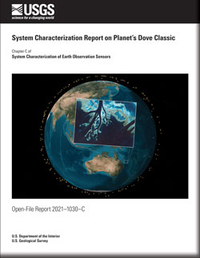System Characterization Report on Planet’s Dove Classic
Links
- Document: Report (31.5 MB pdf)
- Larger Work: This publication is Chapter C of System characterization of Earth observation sensors
- Download citation as: RIS | Dublin Core
Executive Summary
This report addresses system characterization of Planet’s Dove Classic satellites and is part of a series of system characterization reports produced and delivered by the U.S. Geological Survey Earth Resources Observation and Science Cal/Val Center of Excellence. These reports present and detail the methodology and procedures for characterization; present technical and operational information about the specific sensing system being evaluated; and provide a summary of test measurements, data retention practices, data analysis results, and conclusions.
Since 2013, Planet has launched more than 360 Dove 3U CubeSats, where U stands for 10-centimeter (cm) x 10-cm x 10-cm stowed dimensions, each weighing about 5 kilograms. Since 2015, all Dove satellites have had four-band imagers with about a 4-meter (m) pixel ground sample distance. Since 2016, all Doves have been launched into Sun-synchronous orbits varying from 474 to 524 kilometers, with inclinations between 97 and 98 degrees. The Dove series satellites do not have orbit maintenance capabilities; thus, their orbits decay slowly over time, contributing to shorter lifetimes of about 3 years. More information on Planet satellites and sensors is available in the “2020 Joint Agency Commercial Imagery Evaluation—Remote Sensing Satellite Compendium” and from the manufacturer at https://www.planet.com/.
The Earth Resources Observation and Science Cal/Val Center of Excellence system characterization team completed data analyses to characterize the geometric (interior and exterior), radiometric, and spatial performances. Results of these analyses indicate that Dove Classic has an interior geometric performance in the range of −0.218 (−0.073 pixel) to −0.037 m (−0.012 pixel) in easting and −0.167 (−0.056 pixel) to −0.111 m (−0.037 pixel) in northing in band-to-band registration, an exterior geometric error of −6.841 (−2.280 pixels) in easting and −6.235 m (−2.078 pixels) in northing offset in comparison to Landsat 8 Operational Land Imager, a radiometric performance in the range of −0.057 to −0.010 in offset and 0.963 to 1.298 in slope, and a spatial performance in the range of 2.77 to 3.35 pixels for full width at half maximum, with a modulation transfer function at a Nyquist frequency in the range of 0.003 to 0.010.
Suggested Citation
Kim, M., Park, S., Anderson, C., and Stensaas, G.L., 2021, System characterization report on Planet’s Dove Classic, chap. C of Ramaseri Chandra, S.N., comp., System characterization of Earth observation sensors: U.S. Geological Survey Open-File Report 2021–1030, 28 p., https://doi.org/10.3133/ofr20211030C.
ISSN: 2331-1258 (online)
Table of Contents
- Executive Summary
- Introduction
- System Description
- Procedures
- Measurements
- Analysis
- Summary and Conclusions
- Selected References
- Appendix 1. Radiometric Data
| Publication type | Report |
|---|---|
| Publication Subtype | USGS Numbered Series |
| Title | System characterization report on Planet’s Dove Classic |
| Series title | Open-File Report |
| Series number | 2021-1030 |
| Chapter | C |
| DOI | 10.3133/ofr20211030C |
| Publication Date | July 26, 2021 |
| Year Published | 2021 |
| Language | English |
| Publisher | U.S. Geological Survey |
| Publisher location | Reston, VA |
| Contributing office(s) | Earth Resources Observation and Science (EROS) Center |
| Description | v, 28 p. |
| Online Only (Y/N) | Y |


